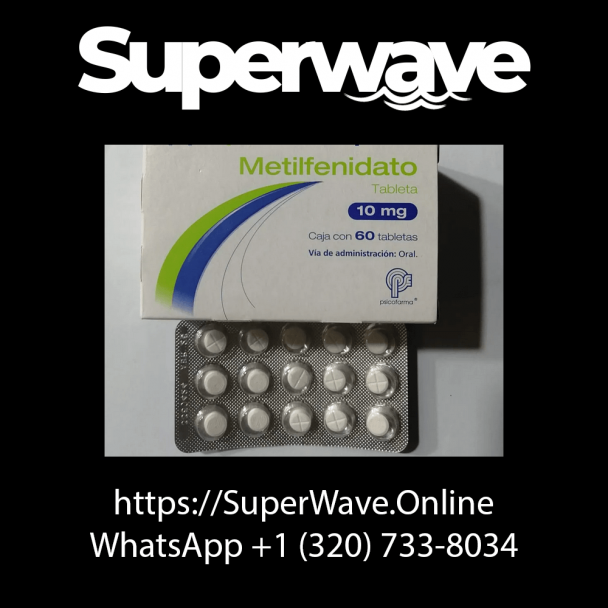Ritalin 10mg
Ritalin (Methylphenidate)
A pharmacist’s plain-language guide to what Ritalin is, how it works, practical dosing notes, and safety tips. Written by the SuperWave Pharmacy team — calm, clear, and human.
Product Overview
Some days your thoughts feel like a dozen browser tabs open at once. For many people with Attention Deficit Hyperactivity Disorder (ADHD) or certain sleep disorders, that’s the nonstop reality. Ritalin (the brand name for methylphenidate) is one of the medications clinicians commonly use to help bring focus and stability back to everyday life.
This page aims to explain Ritalin in straightforward terms — what it does, the forms you’ll see, how to take it safely, and what to expect. Think of it as a pharmacist talking you through the details, not a textbook or a sales pitch.
What is Ritalin?
Ritalin contains the active ingredient methylphenidate, a central nervous system stimulant. It’s approved for treating ADHD in children and adults, and for certain types of excessive daytime sleepiness such as in narcolepsy. It helps increase attention, reduce impulsive behavior, and, for some, make day-to-day tasks more manageable.
Important note: Ritalin is a prescription medication. It’s not a casual energy booster or a study hack. It’s meant to be used under the guidance of a healthcare professional who has evaluated your medical history and current health.
How Ritalin Works — in a pharmacist’s words
Here’s the short, practical explanation. Ritalin increases activity in certain brain chemicals — mainly dopamine and norepinephrine — in areas of the brain involved in attention and impulse control. That helps reduce the “background noise” so you can focus on a task without getting pulled away by every little distraction.
People often expect a dramatic personality change. That’s not how it works. You still think the same way. The difference is that your thoughts line up better; tasks don’t slip away as easily. In many cases, patients describe it like cleaning the windshield — clearer view, same driver.
Forms and Strengths
Methylphenidate is available in multiple formulations. Each one is useful in different real-life situations — and yes, doctors pick them for a reason.
Immediate-release tablets (often called IR) act quickly and last a few hours. They let clinicians fine-tune doses and give patients flexibility if their daily needs vary. Extended-release formulations (sometimes labeled SR, ER, or LA depending on the manufacturer) release medication more slowly and are designed to provide coverage across the school or workday with a single morning dose.
Common strengths you’ll see include lower-dose tablets (5 mg, 10 mg, etc.) up to higher-dose options used with careful monitoring. Dosing is individualized: start low, observe, and adjust in small steps. That’s the safest way to get the benefit without unnecessary side effects.
Who is Ritalin for?
Ritalin is approved for ADHD in children (starting at specified ages depending on the formulation) and adults. It’s also used for narcolepsy when promoting wakefulness is necessary. Clinicians diagnose ADHD based on established criteria, not on a single symptom like trouble focusing. If you suspect you might have ADHD, the right first step is a medical evaluation.
If you have pre-existing conditions — for example, heart disease, high blood pressure, glaucoma, or a personal history of substance misuse — your prescriber will weigh the risks and benefits and may choose a different approach or add monitoring.
How to Take Ritalin Safely
Safety is mostly common-sense and consistency. Take Ritalin exactly as prescribed. If your prescriber says “once in the morning,” take it in the morning. Don’t split extended-release capsules; doing so changes the release pattern.
A few practical tips I tell people at the pharmacy: take it at roughly the same time every day, pay attention to whether it affects appetite or sleep, and keep a short symptom diary during the first few weeks — a note about when focus improves or when side effects appear helps your doctor fine-tune things.
Simple rule: If the medication seems to wear off too soon or causes unwanted symptoms, call your prescriber before changing the dose. Don’t improvise.
Possible Side Effects
Most side effects are mild and often settle after your body adjusts. The more common ones include decreased appetite, dry mouth, mild nervousness, trouble falling asleep, and occasional headache. These are usually manageable and predictable.
Less common but more important to notice: noticeable mood changes, chest pain, fainting, severe headache, or vision changes. If you experience any of those, seek medical attention. Again — better safe than sorry. Your doctor would rather adjust a dose than let a small problem grow into a bigger one.
Practical Lifestyle Tips That Help
Medication is only one part of effective ADHD or narcolepsy care. Small, consistent habits make a big difference. Keep simple, visible lists. Use alarms for transitions. Prioritize sleep — even if you feel more alert during the day, your brain still needs regular rest. And yes, regular meals matter: stimulants can suppress appetite, so plan balanced snacks or meals so you don’t unintentionally skip nutrition.
Therapy, coaching, and structured routines turn the medication’s focus boost into lasting improvements. In my experience, people who combine these measures tend to have steadier, longer-lasting results.
Brand vs Generic
The active ingredient — methylphenidate — is the same in brand and generic versions. Generics meet regulatory standards and are widely used; they’re often more affordable. Some folks notice tiny differences in how the medicine feels due to inactive ingredients, but medically they’re equivalent.
If you notice a difference after switching manufacturers, mention it to your pharmacist. We can often track a specific supplier and help keep your medication consistent.
Long-Term Use and Monitoring
Used under medical supervision, methylphenidate can be part of a long-term treatment plan. Regular check-ins usually include measuring blood pressure, pulse, weight, and mood. If the medication seems to lose effect over months or years, your prescriber will discuss adjustments — not an automatic dose increase, but a thoughtful review.
Some patients take planned breaks under supervision; others continue indefinitely. The decision is personal and clinical. There’s no one-size-fits-all rule.
Important Interactions and Precautions
Ritalin can interact with certain medicines. Antidepressants in particular (especially MAO inhibitors) should not be combined without careful coordination. Certain antacids or vitamin C in large amounts can change absorption. High caffeine intake can amplify stimulant effects and feel uncomfortable.
Always review your full medication list — prescription and non-prescription — with the prescriber and the pharmacist. It’s a short conversation that prevents a lot of trouble.
Storage and Disposal
Keep Ritalin in its original container, tightly closed, and out of reach of children. Because it’s a controlled medication, store it securely. Expired or unused medication should be returned via a take-back program or disposed of according to local guidelines — don’t flush it.
Why Sourcing from Licensed Pharmacies Matters
There’s a reason pharmacies verify prescriptions and follow strict sourcing protocols. Stimulant medications are sometimes counterfeited or mishandled. Licensed pharmacies ensure traceability, proper storage, and professional oversight. At SuperWave, prescriptions are checked and verified, and our pharmacists are available to answer questions about dosing, side effects, or interactions.
We care about the whole process — not just handing over a bottle. That’s what keeps patients safe and treatment effective.
Frequently Asked Questions
How long does Ritalin last?
For immediate-release tablets, effects typically last around 3–5 hours. Extended-release formulations can provide coverage from roughly 6 up to 12 hours depending on the product and the person.
What if my child refuses to eat on Ritalin?
Appetite suppression is common. Try offering nutrient-dense snacks and a consistent mealtime routine. If weight gain or growth becomes a concern, discuss it with your pediatrician — small adjustments to timing or dosage may help.
Can I drink coffee while taking Ritalin?
A modest amount of caffeine is generally fine, but excessive caffeine can amplify jitteriness or raise your heart rate. If you’re sensitive, reduce intake and monitor how you feel.
Is Ritalin addictive?
When used exactly as prescribed for ADHD or narcolepsy, the risk of addiction is low. Misuse — taking higher doses or using without a prescription — is where dependence and harm occur. Always follow your prescriber’s guidance.
How soon will I notice a benefit?
Some people notice improved focus within an hour for immediate-release forms or within the day for extended-release. For others, it takes a few trials of dosage adjustments to find the right rhythm. Keep notes and communicate with your prescriber; it makes the process faster and smoother.
Parting Notes from Your Pharmacist
Ritalin is a well-established tool for managing ADHD and symptoms of excessive daytime sleepiness. It’s effective for many, and it’s also something that benefits from thoughtful use. If you’re starting treatment, keep an open line with your prescriber and pharmacist. Little details — timing, diet, sleep habits — often make a big difference.
If you have questions about side effects, interactions, or how it fits into your daily life, reach out to your local pharmacist. We see how real people live with these medicines, and sometimes a short, practical tip makes all the difference.


